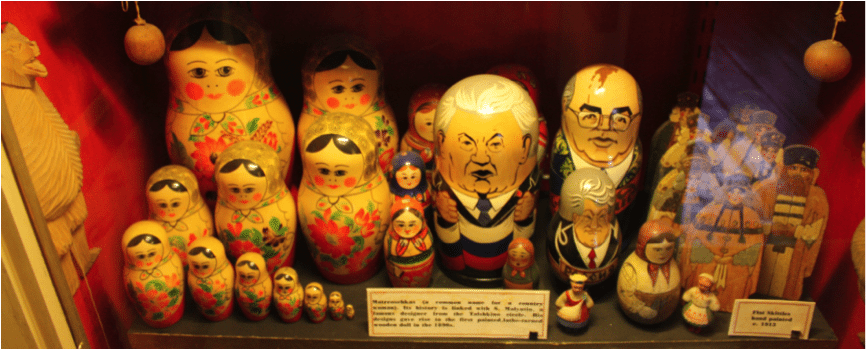A treasure trove of children’s toys
Pollock’s Toy Museum occupies two houses joined together in the heart of Fitzrovia and is one of London’s hidden gems. The Museum takes its name from Benjamin Pollock, the last of the Victorian Toy Theatre printers. It was set up in 1956 by Marguerite Fawdry, who bought up the stock of Benjamin Pollock Ltd., after trying to purchase wire slides. The Museum was originally located near Covent Garden, but the collection outgrew the premises and so moved to Scala Street in 1969, where the museum now resides.
Fawdry’s death in 1996 meant that the museum unfortunately lost its creative core. With the poor distribution of arts funding amplified by the bias towards towards STEM (Science, Technology, Engineering, Mathematics), Pollock’s Toy Museum is an example of culture forcing its way against the tide. But the question is, will it continue to stand strong?
London hacks know about Pollock’s through its two amazing toy shops, but while these look great, the museum is less appealing. Both shops, one in Covent Garden and the other on Scala Street, with the museum located upstairs, are a tourist and heritage lover’s treasure trove. While the downstairs shop is organised beautifully, the upstairs museum is in urgent need of a revamp. The museum swings between feeling claustrophobic, to having the quaint charm of pokiness. Either way, it looks as if your great-great grandmother’s house turned into a cabinet of curiosities. The museum is organised well even though no space is left spared. The displays, though, seem to display too much of the same thing. Having scrapped plans for expansion, Pollock’s impressive collection cannot be appreciated properly because it has outgrown its premises.
Negatives aside, the main reason to visit to Pollock’s Museum is its appeal both to the inner-grandparent and the inner-child. Pollock’s only equivalent in London is the V&A Museum of Childhood, but there is a clear difference between the two. Unlike the V&A Museum, Pollock’s doesn’t have famous trustees, or great funding and resources. Consequently, while the V&A Museum of Childhood is fantastic for giving a social commentary on modern toys, Pollock’s is different. The V&A exhibits pristine, expensive toys which essentially look like art, cases in point are its extravagant doll houses. Pollock’s Museum, by contrast, is perfect for those who lust over all things vintage and binge on television shows like Bargain Hunt or Antiques Roadshow. Despite its limited scope, what makes this museum unique, is that it was made with the child in mind. It is not just a collector’s playground but a nostalgic tour through historic childhoods.
For me, the main attraction about Pollock’s is that it is clear that these toys have been used and had lives before being housed in the museum. Pollock’s only features toys from between the nineteenth century until just after the Second World War. It boasts, amongst its expansive collection, board games, English tin toys and puppets, folk toys from tribes in Africa, Europe and East Asia. It has a slight American slant, an interesting display of tribal and East Asian dolls and even a 2,000 year old Egyptian clay mouse. The museum has been organised in a way that allows you to think about the child who played with them, back when they were in mint condition. Some of the toys are even accompanied with photographs of their original owners. It is precisely these personal touches which make Pollock’s transcend such criticisms as: ‘the exhibition is not physically engaging’, because you cannot touch the toys, or ‘it’s not innovative’ since there is only one permanent exhibition.
I believe that the main reason why Pollock’s is still standing is because it exhibits toys which we can imagine ourselves having played with. Consider Toy Story 2: be they chipped, broken and hand made, it is the imperfect nature of the toys which makes you love them. In your own childhood, think of the Barbies whose hair you rudely cut off, raggedy teddy bears you bathed and the board games which suffered their wear and tear. It is these idiosyncrasies which made us love and care for childhood toys. Regardless of whether or not you are obsessed with all things Edwardian and Victorian, each of the toys exhibited have personalities of their own, just like the ones we used to play with. Pollock’s does well to encourage thoughts about the universality of the childhood experience.
It seems a shame that the museum no longer accepts toy donations, lacking the room to display anything more in the exhibition space. I believe the ticket prices are reasonable and the museum a treasure that is well worth a visit. For now, the museum is still kept as it was under Fawndry’s directorship. I just hope that because of this stasis, the museum doesn’t disappear and turn into another forsaken Starbucks.
Pollock’s Toy Museum is open Monday to Saturday 10am-5pm, Concessions £5

Comments